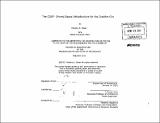| dc.contributor.advisor | J. Meejin Yoon. | en_US |
| dc.contributor.author | Olson, Timothy R. (Timothy Richard) | en_US |
| dc.contributor.other | Massachusetts Institute of Technology. Dept. of Architecture. | en_US |
| dc.coverage.spatial | n-us-ma | en_US |
| dc.date.accessioned | 2011-05-23T18:09:44Z | |
| dc.date.available | 2011-05-23T18:09:44Z | |
| dc.date.copyright | 2011 | en_US |
| dc.date.issued | 2011 | en_US |
| dc.identifier.uri | http://hdl.handle.net/1721.1/63054 | |
| dc.description | Thesis (M. Arch.)--Massachusetts Institute of Technology, Dept. of Architecture, 2011. | en_US |
| dc.description | Cataloged from PDF version of thesis. | en_US |
| dc.description | Includes bibliographical references (p. 79). | en_US |
| dc.description.abstract | The urban mainstream suffers from a lack of space. Kitchens are too small to hold a gathering of friends. Spare bedrooms, garages, basements, offices and parlors are foregone in the interest of compaction. The Rise of the Creative Class, an economic engine with its roots in the city, faces an especially challenging relationship to space. While the vitality of urban density is paramount to the success and growth of creative economies, a lack of available affordable space curtails the potential growth of home brewed culture, entrepreneurship and industry. This project engages this resource gap by imagining a cooperative model as a core infrastructure for the creative city. The context for this project is within the future Innovation District of Boston on the Fan Pier Boston site. The innovation District is currently being imagined by the City of Boston, the Boston Redevelopment Authority, developers, architects and planners as a mixed-use neighborhood with the economic and cultural energy to attract a global creative class workforce. Fan Pier Boston is a flagship development within the Innovation District. Due to ongoing global recession, 7 of the 8 buildings proposed for the site have been deferred. The COOP is situated in this interim period, between the existing expanse of parking lots that occupy Fan Pier Boston today, and its future promise as a hub of global innovation. The COOP condenses the vitality of a creative city onto the site of the Fan Pier. Membership owned kitchens workshops and film studios combined with public event spaces for film screening, art openings and concerts anticipate a future creative class urban fabric for the future Boston Innovation District. | en_US |
| dc.description.statementofresponsibility | by Timothy R. Olson. | en_US |
| dc.format.extent | 81 p. | en_US |
| dc.language.iso | eng | en_US |
| dc.publisher | Massachusetts Institute of Technology | en_US |
| dc.rights | M.I.T. theses are protected by
copyright. They may be viewed from this source for any purpose, but
reproduction or distribution in any format is prohibited without written
permission. See provided URL for inquiries about permission. | en_US |
| dc.rights.uri | http://dspace.mit.edu/handle/1721.1/7582 | en_US |
| dc.subject | Architecture. | en_US |
| dc.title | The COOP : shared space infrastructure for the creative city | en_US |
| dc.title.alternative | Shared space infrastructure for the creative city | en_US |
| dc.type | Thesis | en_US |
| dc.description.degree | M.Arch. | en_US |
| dc.contributor.department | Massachusetts Institute of Technology. Department of Architecture | |
| dc.identifier.oclc | 723137542 | en_US |
